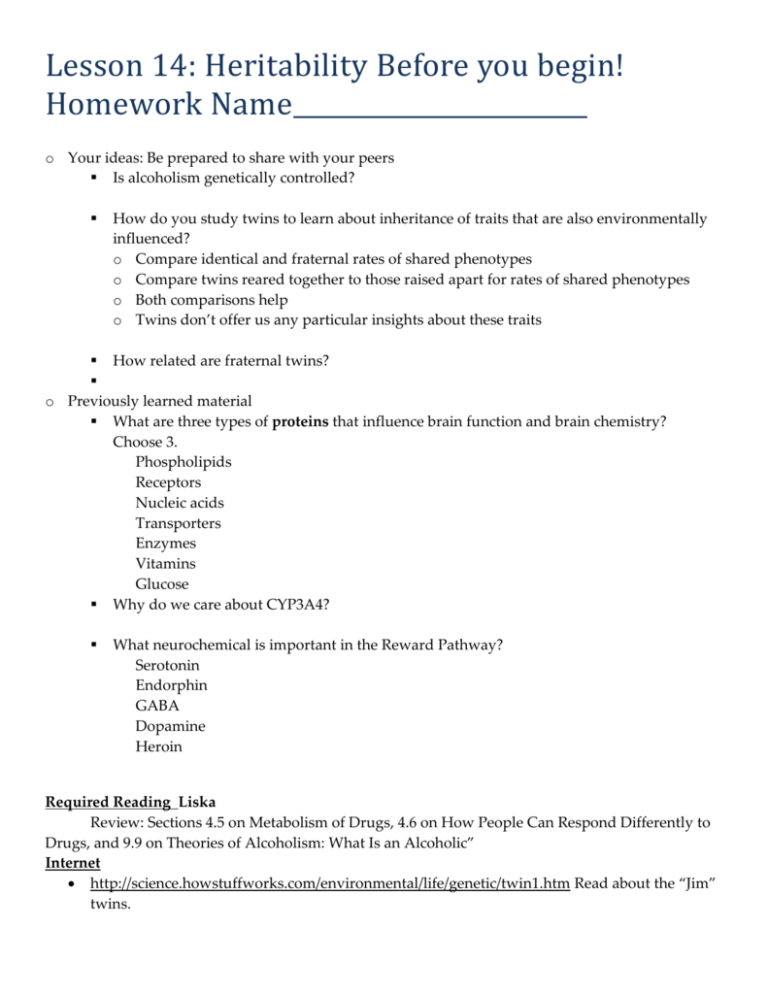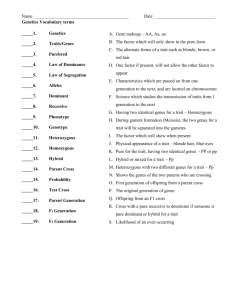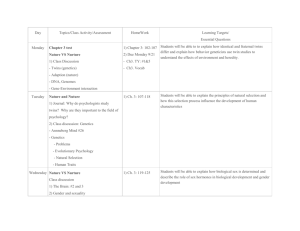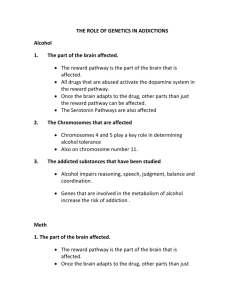Unit 3 Lesson 14: Heritability HW Lesson14BYBHW
advertisement

Lesson 14: Heritability Before you begin! Homework Name o Your ideas: Be prepared to share with your peers Is alcoholism genetically controlled? How do you study twins to learn about inheritance of traits that are also environmentally influenced? o Compare identical and fraternal rates of shared phenotypes o Compare twins reared together to those raised apart for rates of shared phenotypes o Both comparisons help o Twins don’t offer us any particular insights about these traits How related are fraternal twins? o Previously learned material What are three types of proteins that influence brain function and brain chemistry? Choose 3. Phospholipids Receptors Nucleic acids Transporters Enzymes Vitamins Glucose Why do we care about CYP3A4? What neurochemical is important in the Reward Pathway? Serotonin Endorphin GABA Dopamine Heroin Required Reading Liska Review: Sections 4.5 on Metabolism of Drugs, 4.6 on How People Can Respond Differently to Drugs, and 9.9 on Theories of Alcoholism: What Is an Alcoholic” Internet http://science.howstuffworks.com/environmental/life/genetic/twin1.htm Read about the “Jim” twins. http://en.wikipedia.org/wiki/Concordance_%28genetics%29 Read about measurements in twin studies. http://learn.genetics.utah.edu/content/addiction/candidate/ Read about identifying specific genes related to addiction-Activity 7 http://learn.genetics.utah.edu/content/addiction/genes/ Read about discovering the genetic underpinnings of addiction. http://learn.genetics.utah.edu/content/pharma/ Read about “designer” drugs – drugs targeting specific individuals more than others-Activity 9 Supplemental Reading Internet http://science.howstuffworks.com/environmental/life/genetic/twin2.htm (basics on twinning) At http://learn.genetics.utah.edu/content/pharma/ feel free to peruse other links, in particular the one about “Issues” related to pharmacogenetics. For a mathematical approach to heritability see: http://en.wikipedia.org/wiki/Heritability Guiding Questions 1. What do model organisms have to offer us as we study complex behavioral traits? 2. If genes control a trait, in part, what can you expect for twins? 3. What types of genes might influence drug taking and how are specific genes determined to be (or not to be) influential in a trait? 4. What types of genes influence addiction to alcohol, or addiction generally. 5. What is pharmacogenetics and how might this field of study influence the drugs you will be prescribed in 10 years time? Key Terms Identical and fraternal twins Concordant vs. discordant Reward Deficiency Syndrome Pharmacogenetics Need to pick this up-Lesson 12 Activity Eight: Pedigree Analysis While Punnett squares are useful for solving problems with organisms that have large numbers of offspring, human pairs often have small enough families that proportions are not particularly handy to solve the inheritance pattern of a trait. Often a geneticist will examine MANY families to determine how a trait is inherited. Each family’s information is summarized in this kind of a study by making a “family tree” or a pedigree. Pedigrees are diagrams that show familial relationships in a standard (and therefore easy to interpret by others) way and represents the phenotype of each individual in the family. Conventions used to make and solve pedigrees: Circles represent women and girls Squares represent men and boys Filled symbols represent people with “the trait” (a disease or a phenotype of interest). Empty symbols represent people who do NOT have “the trait” If the trait shows incomplete dominance, the symbols will be hatched or have a dot in the middle Matings are connected by a line between a male and a female Offspring from a mating arise from a stem below that line, and are given in order of birth from a “sib line” Twins descend from the sib line as a pair, either directly from the sib line (fraternal twins) or from a stem off the sib line that then forks (identical twins) Visit the interactive pedigree-making site at http://learn.genetics.utah.edu/content/addiction/genetics/pi.html Activity One: History Side Bar At http://science.howstuffworks.com/environmental/life/genetic/twin1.htm : read about the identical twins, separated at birth, and both named “Jim”. Activity Seven: Candidate Gene Approach Homework to prepare for discussion Work through the activities found at : http://learn.genetics.utah.edu/content/addiction/candidate/ Some of this is new material (we haven’t talked about nicotine yet but soon will), but in the section “Where do We Begin” – it does suggest one way, different from the story of Dr. Heberlein, that researchers look for particular genes that might be good candidates for ones influencing drug use. Some of this material is also review. Pay particular attention to the 5 slides in the section “How Genes Affect Behavior”. Be able to answer the question How is the protein encoded by allele 1 different from the proteins encoded by alleles 2 and 3? Try to come up with a molecular answer and a functional answer. Activity Eight: Reward Deficiency Syndrome: More detail The dopamine receptor gene mentioned in activity six is also implicated in the addictions to numerous substances and even addictive behaviors. For each neurotransmitter, there are several known receptors. The dopamine receptor 2 (D2DR or DRD2) is strongly implicated in addictions. Read the abstract by Blum K, Braverman ER, Holder JM, Lubar JF, Monastra VJ, Miller D, Lubar JO, Chen TJ, Comings DE, Found in 2000 J. Psychoactive Drugs Some terms you might be unfamiliar with Mesolimbic – the area around the limbic system – in particular the nucleus accumbens Enkephalin – an endogenous opiate, like endorphin Substantia niagra – an area of the brain that utilizes dopamine and controls movement Pleiotropic – many causes, both genetic and otherwise The dopaminergic system, and in particular the dopamine D2 receptor, has been implicated in reward mechanisms. The net effect of neurotransmitter interaction at the mesolimbic brain region induces "reward" when dopamine (DA) is released from the neuron at the nucleus accumbens and interacts with a dopamine D2 receptor. "The reward cascade" involves the release of serotonin, which in turn at the hypothalmus stimulates enkephalin, which in turn inhibits GABA at the substania nigra, which in turn fine tunes the amount of DA released at the nucleus accumbens or "reward site." It is well known that under normal conditions in the reward site DA works to maintain our normal drives. In fact, DA has become to be known as the "pleasure molecule" and/or the "antistress molecule." When DA is released into the synapse, it stimulates a number a DA receptors (D1-D5) which results in increased feelings of well-being and stress reduction. A consensus of the literature suggests that when there is a dysfunction in the brain reward cascade, which could be caused by certain genetic variants (polygenic), especially in the DA system causing a hypodopaminergic trait, the brain of that person requires a DA fix to feel good. This trait leads to multiple drug-seeking behavior. This is so because alcohol, cocaine, heroin, marijuana, nicotine, and glucose all cause activation and neuronal release of brain DA, which could heal the abnormal cravings. Certainly after ten years of study we could say with confidence that carriers of the DAD2 receptor A1 allele have compromised D2 receptors. Therefore lack of D2 receptors causes individuals to have a high risk for multiple addictive, impulsive and compulsive behavioral propensities, such as severe alcoholism, cocaine, heroin, marijuana and nicotine use, glucose bingeing, pathological gambling, sex addiction, ADHD, Tourette's Syndrome, autism, chronic violence, posttraumatic stress disorder, schizoid/avoidant cluster, conduct disorder and antisocial behavior. In order to explain the breakdown of the reward cascade due to both multiple genes and environmental stimuli (pleiotropism) and resultant aberrant behaviors, Blum united this hypodopaminergic trait under the rubric of a reward deficiency syndrome. Reward deficiency syndrome thus is a state of mind that causes people to seek “more extreme” ways to satisfy the demands of their reward pathway. Activity Nine: Pharmacogenetics Start by visiting http://learn.genetics.utah.edu/content/pharma/. Select the link “Your Doctor’s New Genetic Tools”. Work through this animation, using the following guiding questions as you read: What is pharmacogenetics? Why might it be beneficial – how will it change medicine? What is Purinethol? Why is it not an ideal chemotherapy for leukemia patients? What is the TPMT enzyme and how does it relate to leukemia patients and Purinethol? What did the doctor discover about Latrice and how did this influence the medication he recommended? In Lecture: Record responses to discussion questions How would you study the role of genes? How would you determine if a trait was inherited? What is the difference between concordant and discordant in twins? Can one have an addictive personality? What type of genes should we consider when talking about drugs? Even with all this genetic info, does this mean one WILL be an alcoholic?







